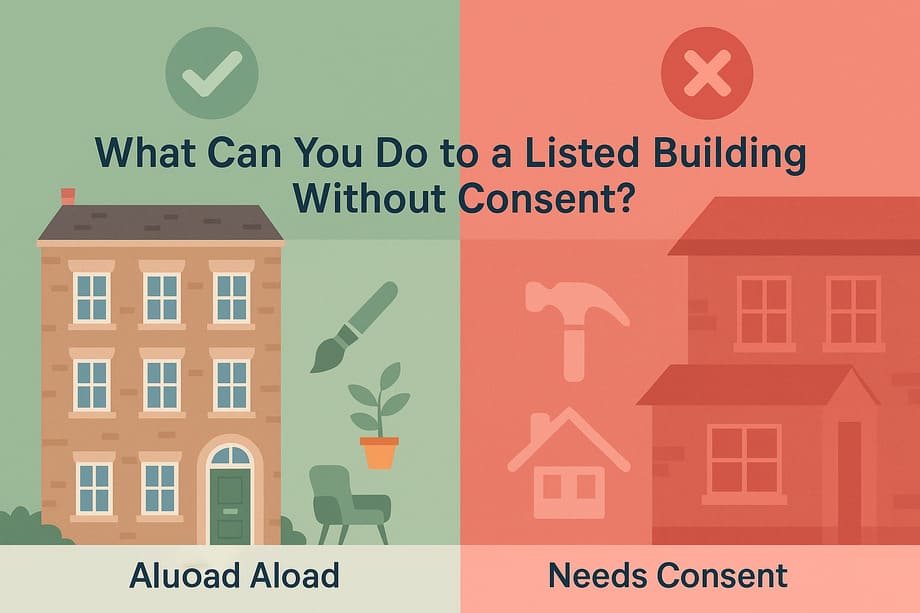What Can You Do to a Listed Building Without Consent? UK Guide 2025

Owning a listed building brings unique responsibilities alongside the privilege of preserving architectural heritage. Many owners worry that every minor repair requires formal permission, creating unnecessary delays and costs. Understanding what you can do to a listed building without consent helps you maintain your property confidently within the law.
This guide clarifies exactly what works you can undertake without listed building consent, explains the crucial “like-for-like” principle, and helps you avoid the serious legal consequences of unauthorised alterations.
Understanding Listed Building Consent
Listed building consent represents legal permission required before altering properties of special architectural or historic interest. The Planning (Listed Buildings and Conservation Areas) Act 1990 protects approximately 400,000 buildings across the UK, ensuring their character endures for future generations.
Buildings earn listing through evaluation by Historic England. Grade I properties include the most outstanding buildings, historic castles and significant stately homes. Grade II* buildings possess particularly important architectural merit. Grade II listings, representing about 92% of all listed properties, still denote buildings of considerable interest and importance.
Critically, listing protection extends to the entire building, not merely features mentioned in the listing description. This includes all internal rooms, external elevations, roof structures, and any buildings within the curtilage such as boundary walls, gates, and outbuildings.
What You Can Do Without Listed Building Consent
Fortunately, routine property maintenance doesn’t require formal applications for every small task. Several categories of work can proceed without consent, provided they meet specific criteria.
Like-for-Like Repairs and Routine Maintenance
The fundamental principle centres on like-for-like repairs using identical materials, matching existing design precisely, and employing traditional building techniques appropriate to the property. The key test asks whether the work affects the building’s special architectural or historic interest.
Routine maintenance that doesn’t require consent includes:
Repairs using matching materials:
- Replacing individual broken roof tiles with exact matches
- Repointing small sections of brickwork using lime mortar matching the original mix
- Repairing damaged timber with matching wood species
- Fixing minor plaster damage using appropriate lime plaster
- Replacing damaged slates with matching salvaged or new slates
Regular maintenance:
- Clearing gutters and maintaining drainage systems
- Treating woodwork against rot and decay
- Securing loose elements like flashings
- Fixing squeaking floorboards
- Maintaining painted surfaces in similar colours
The distinction lies in preservation versus alteration, you’re keeping the building in good condition using methods and materials consistent with its historic construction. Documentation proves invaluable should questions arise. Photograph existing conditions before repairs begin and keep records of materials used.
Interior Redecoration and Modern Fittings
Refreshing your living space doesn’t automatically require consent, though limitations apply:
Works you can do:
- Repainting internal walls using standard paints (provided you’re not affecting historic decorative schemes)
- Hanging new wallpaper in most rooms
- Updating colour schemes in living spaces
- Replacing genuinely modern kitchen units and appliances (those installed within recent decades)
- Updating contemporary bathroom suites
- Replacing modern light fixtures and fittings
Important exceptions:
- Historic paint analysis sometimes reveals significant decorative schemes beneath modern finishes. Removing or covering these layers requires consent
- Original or historic fixtures demand protection Victorian bathroom fittings, Edwardian kitchen ranges, or period light fixtures likely contribute to special interest and require consent for removal
- If fittings are contemporary with the building’s construction, they probably need consent for replacement
The critical question asks whether fittings form part of the building’s special interest. A Victorian bathroom with original fittings represents rare survival worthy of protection. A bathroom refitted in the 1990s holds no such significance.
Minor External Maintenance
External maintenance follows similar principles, though external changes attract closer scrutiny:
Permitted maintenance:
- Repainting external woodwork in similar colours to existing finishes
- Repainting rendered walls in colours matching or closely approximating existing schemes
- Minor roof repairs using matching materials (individual slates, tiles)
- Cleaning painted external joinery
- Treating timber against decay
- Maintaining gardens and grounds (except listed structures)
Requires consent:
- Painting previously unpainted masonry
- Major colour changes affecting the building’s character
- Extensive re-roofing affecting large areas
- Removing render to expose brickwork
- Any work to curtilage structures (walls, gates, outbuildings)
Works Always Requiring Listed Building Consent
Certain changes always need formal permission, regardless of materials or methods used.
Structural and Layout Changes
Any alteration to your property’s internal arrangement requires consent:
- Removing internal walls or creating new openings between rooms
- Blocking up doorways or changing room configurations
- Removing or altering chimney breasts
- Changing staircases, balustrades, or landings
- Installing or removing partitions that affect historic layout
- Creating ensuite bathrooms within historic bedrooms
- Opening up or subdividing existing rooms
Historic room layouts reveal how people lived across centuries—conservation officers protect these arrangements carefully.
Windows, Doors, and External Features
Always requiring consent:
- Replacing windows or doors (even with exact replicas)
- Installing double glazing in place of original single glazing
- Replacing timber windows with uPVC (almost universally refused)
- Changing external door designs or materials
- Adding or removing window openings
- Altering window sizes or proportions
Important distinction: Repairing historic windows by splicing in new timber to replace decayed sections generally avoids consent requirements. Completely replacing windows, even with identical copies, constitutes alteration requiring permission.
Secondary glazing fitted internally without damaging original windows sometimes receives approval where double glazing wouldn’t.
Historic Features and Original Fabric
Removing, replacing, or substantially altering original architectural features requires consent without exception:
- Wall panelling and decorative plasterwork
- Cornices, ceiling roses, and decorative mouldings
- Dado rails, picture rails, and skirtings
- Fireplaces and chimneypieces (even in secondary rooms)
- Historic flooring (stone flags, original floorboards, parquet, decorative tiles)
- Original lighting fixtures and period ironmongery
- Victorian bathroom sets or Edwardian kitchen ranges
- Any fixtures contemporary with the building’s construction
Even replacing damaged sections with exact replicas needs consent, as the work affects original fabric.
Extensions and Major Alterations
Always requiring consent:
- Any extension or addition (regardless of size)
- Demolishing any part of the building (partial or total)
- Altering boundary walls, gates, or railings
- Building outbuildings or garden structures
- Changes of use requiring physical alterations
- Installing building services (heating, ventilation, insulation)
- Adding renewable energy equipment (solar panels, heat pumps)
- Installing satellite dishes or telecommunications equipment
The “Like-for-Like” Principle Explained
The phrase “like-for-like” causes considerable confusion. Understanding what this truly means helps you undertake appropriate repairs confidently.
Like-for-like requires three exact matches:
1. Materials: Identical composition, appearance, and performance
- Traditional lime mortar (not cement substitutes)
- Natural slate (not artificial alternatives)
- Oak timber matching original oak (not softwood replacements)
- Historic brick types matching original
- Traditional lime plaster (not modern gypsum)
2. Design: Exact replication of every detail
- Glazing bar profiles matching precisely
- Timber sections identical to originals
- Moulding profiles exactly replicated
- Joint types matching original construction
- Hardware and ironmongery matching period details
3. Techniques: Historically appropriate methods
- Traditional lime plastering techniques
- Period-appropriate timber joinery
- Stone masonry methods matching original
- Historic paint application methods
- Traditional leadwork or roofing techniques
Key distinction – Repair vs Replacement:
- Repair (usually consent-free): Splicing new timber into existing windows, repointing limited wall areas, replacing individual damaged elements while retaining maximum original fabric
- Replacement (needs consent): Complete window replacement, extensive re-roofing, wholesale renewal of features even using identical materials
Scale influences interpretation. Small-scale repairs typically proceed without consent. Extensive repairs involving large areas might require consent even using like-for-like approaches, as cumulative impact affects the building’s character through substantial loss of original fabric.
Emergency Works Without Prior Consent
Genuine emergencies sometimes demand immediate action. Emergency works can proceed without prior consent only when:
All these conditions apply:
- Immediately necessary for safety, health, or building preservation
- Delay would cause significant harm
- Represents minimum intervention necessary to address the immediate emergency
- No practical alternative exists (temporary measures insufficient)
Examples of genuine emergencies:
- Making dangerous structures safe to prevent imminent collapse
- Preventing serious water ingress threatening major damage
- Securing areas where structural failure threatens public safety
- Arresting deterioration that cannot wait for normal consent procedures
Critical requirement: You must notify your local planning authority in writing as soon as reasonably practicable, explaining the emergency, describing works undertaken, and justifying why prior consent proved impractical.
Following emergency stabilisation, obtaining formal consent for permanent repairs remains essential. Conservation officers understand emergencies required immediate action, but permanent remedial work needs proper assessment and approval.
Serious Consequences of Unauthorised Work
Undertaking alterations without required consent constitutes a criminal offence carrying serious penalties.
Legal consequences:
- Maximum penalty: Two years imprisonment or unlimited fines
- Criminal offences apply to anyone carrying out or instructing the work
- Claiming ignorance that a building was listed provides no defence
- Both property owners and contractors face liability
Enforcement powers:
- Local planning authorities can require unauthorised work to be reversed
- Listed building enforcement notices remain enforceable indefinitely
- No time limit exists on requiring reversal of unauthorised alterations
- Notices are entered on Local Land Charges Register
Practical implications:
- Property sales commonly collapse when unauthorised work is discovered
- Buyers’ solicitors routinely investigate whether alterations received approvals
- Mortgage lenders may refuse mortgages until issues are resolved
- Insurance companies may refuse cover for damage related to unauthorised works
- Reversing unauthorised alterations often costs substantially more than obtaining proper consent would have done
Inherited liability: Purchasing a listed building transfers responsibility for all unauthorised works. You inherit previous owners’ breaches regardless of when they occurred.
Retrospective consent: Applications describing works already completed can request approval after the fact. Obviously appropriate works might receive retrospective approval, but harmful alterations face refusal, leaving reversal as the only option.
How to Check if Works Need Consent
Follow these steps:
- Review your listing description on the Historic England website to understand your building’s special interest
- Apply the fundamental test: Does the work affect the building’s character as a structure of special architectural or historic interest?
- Distinguish repair from alteration: Repairing existing elements using identical materials typically avoids consent. Altering, replacing, or introducing new elements usually requires permission.
- Contact your conservation officer for informal pre-application advice (often free or low-cost)
- Apply for a Certificate of Lawfulness when uncertainty exists—this formal application costs nothing and provides binding determination whether proposed works require consent
Frequently Asked Questions
Can I repaint my listed building’s exterior without consent?
Repainting in colours matching or closely approximating existing finishes typically avoids consent requirements. However, painting previously unpainted masonry or dramatically changing colours requires consent.
Do I need consent to replace my kitchen and bathroom?
Replacing genuinely modern fittings (installed within recent decades) doesn’t usually require consent. However, period fixtures contemporary with the building’s construction require consent for removal or replacement.
What if I buy a property with unauthorised alterations?
You inherit responsibility for all unauthorised works. No time limit exists for enforcement action. Always investigate thoroughly whether alterations received proper consent before purchasing.
Can I install double glazing?
Replacing original single glazing with double-glazed units requires consent and faces strong resistance from most conservation officers. Secondary glazing fitted internally sometimes receives approval.
How long does it take to get a decision?
Certificate of Lawfulness applications typically receive decisions within eight weeks. Full listed building consent applications take eight to thirteen weeks depending on complexity.
What evidence should I keep when doing work without consent?
Maintain comprehensive photographic records documenting conditions before repairs, materials used, and techniques employed. Keep invoices showing traditional materials purchased and records of any specialist advice received.
Summary: Your Quick Reference
Usually OK Without Consent:
- Like-for-like repairs using matching materials
- Routine maintenance (gutters, treating timber, minor fixes)
- Repainting in similar colours
- Replacing modern kitchen/bathroom fittings
- Interior redecoration not affecting historic surfaces
Always Needs Consent:
- Replacing windows or doors (even like-for-like)
- Removing walls or changing layouts
- Removing historic features (fireplaces, panelling, plasterwork)
- Extensions or demolition
- Installing insulation or major building services
- Altering boundary walls or outbuildings
Key Principles:
- Like-for-Like = Same materials + same design + same methods
- Whole building is protected, not just listed features
- Repair usually OK, replacement needs consent
- When in doubt, ask your conservation officer first
- Document everything with photos and records
Critical Warnings:
- Unauthorised work = criminal offence (up to 2 years imprisonment)
- Ignorance is no defence
- No time limit on enforcement action
- Affects property sales and mortgages
- You inherit previous owners’ unauthorised work
Getting Help:
- Local Planning Authority conservation officer for advice
- Certificate of Lawfulness for free formal confirmation
- Historic England for general guidance
- Pre-application advice before formal applications
This guide provides general information about listed building consent requirements based on current UK law. Listed buildings vary greatly, and each case receives individual assessment by local planning authorities. Always consult your local authority conservation officer before undertaking works if you’re uncertain whether consent is required. Last updated: October 2025.
Last Updated on October 15, 2025 by James Cartwright







